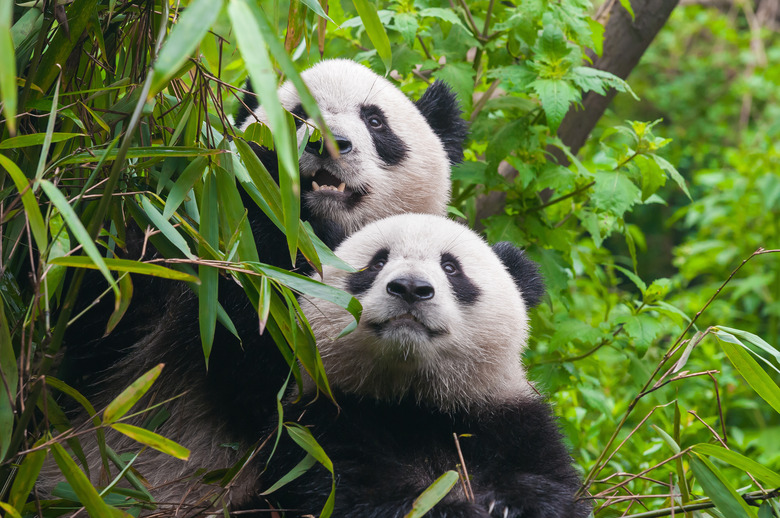Animals Of The Bamboo Forest
Bamboos are giant grasses renowned for the speed with which they grow and their diverse utility. Better than 1,200 species across some 90 genera populate a truly vast range centered on the tropics and subtropics but also extending into some temperate regions. While wild bamboo commonly grows in riverside brakes or understory thickets, in places it forms large, monotypic stands — true bamboo forests — somewhat unusual among tropical vegetation communities, typically so diverse. These ecosystems support a wealth of animal species, including some that have evolved with exceptionally close ties to bamboo.
Asian Bamboo Ecosystems
Asian Bamboo Ecosystems
Asian bamboo forests claim the most extensive acreage and the most species richness anywhere in the world. China has more than 500 kinds of native bamboo and is the home of the creature most intrinsically associated with the outsized grass: the giant panda. Resident in an incredibly diminished range in central China's mist-sheathed mountains, this highly specialized bear feeds almost exclusively on bamboo. Still saddled with the short digestive tract of a carnivore, the panda's ability to render nutrients from bamboo is quite inefficient, so it must spend most of its waking hours consuming epic quantities. Other Asian animals noted for bamboo-heavy diets are the red panda — a raccoon-like Himalayan carnivore unrelated to the giant panda — and the widespread bamboo rats. Asian elephants — the largest mammals on the continent — often forage and shelter in bamboo forests, which also are prime hunting grounds for snakes such as India's bamboo viper.
Bamboo Forests of Continental Africa
Bamboo Forests of Continental Africa
Some of Africa's most extensive tracts of bamboo lie in the well-watered highlands of the East African Rift and associated regions, belting isolated peaks such as Mount Kenya and Mount Kilimanjaro as well as middle elevations of the Aberdare, Rwenzori and Virunga mountains. The two subspecies of the eastern gorilla — the mountain and eastern lowland gorillas — commonly feed in high-elevation bamboo forests along the Albertine Rift. For example, mountain gorillas in the Virunga Mountains, a tract of stratovolcanoes along the Rwanda, Democratic Republic of the Congo and Uganda border, visit the range's bamboo realm whenever new shoots — a preferred food — are available. Other inhabitants of montane bamboo forests in Africa include giant forest hogs, African elephants, mountain bongos — a critically endangered forest antelope favoring bamboo thickets and other dense secondary growth — and a host of birds and reptiles.
Madagascar's Bamboo Forests
Madagascar's Bamboo Forests
Africa in general harbors low bamboo diversity, but Madagascar — that big, long-isolated island off the continent's eastern coast — proves an exception, with some 32 native species. Bamboos are particularly extensive in the wet, trade-wind forests of Madagascar's eastern coastal lowlands and escarpments, forming both understory layers as well as jungle thickets where logging or fire has cleared primary forest. Among the iconic animals here are the bamboo lemurs, a genus of lemur — a primitive primate endemic to Madagascar — mainly specialized for bamboo habitats and diets. One species, however, the Alaotran gentle lemur, actually dwells in reed/papyrus marshes fringing Lake Alaotra: a particularly unusual environment not just for a bamboo lemur but for any primate.
Bamboo Ecosystems of the Americas
Bamboo Ecosystems of the Americas
The tropical Americas support significant bamboo resources. Brazil includes some 9 million hectares (35,000 square miles) of bamboo forest, which is extensive in both upland and floodplain sites in the Amazon Basin as well as the country's Atlantic Forest, which fringes the eastern coast. Some South American birds are bamboo specialists, such as the spotted bamboo-wren of the Atlantic Forest and the bamboo foliage-gleaner of the Amazon. North America has its own native bamboos, the canes, which formerly carpeted many river floodplains in the eastern United States in thick "canebrakes." Canebrakes were important habitat for the striking Carolina parakeet, once widespread east of the Rockies but extirpated in the early 20th century. "Canebrake rattlesnake" is the common name in the American South for the timber rattler, referencing this venomous serpent's predilection for the bottomland ecosystem.
Cite This Article
MLA
Shaw, Ethan. "Animals Of The Bamboo Forest" sciencing.com, https://www.sciencing.com/animals-bamboo-forest-8031342/. 13 March 2018.
APA
Shaw, Ethan. (2018, March 13). Animals Of The Bamboo Forest. sciencing.com. Retrieved from https://www.sciencing.com/animals-bamboo-forest-8031342/
Chicago
Shaw, Ethan. Animals Of The Bamboo Forest last modified August 30, 2022. https://www.sciencing.com/animals-bamboo-forest-8031342/
